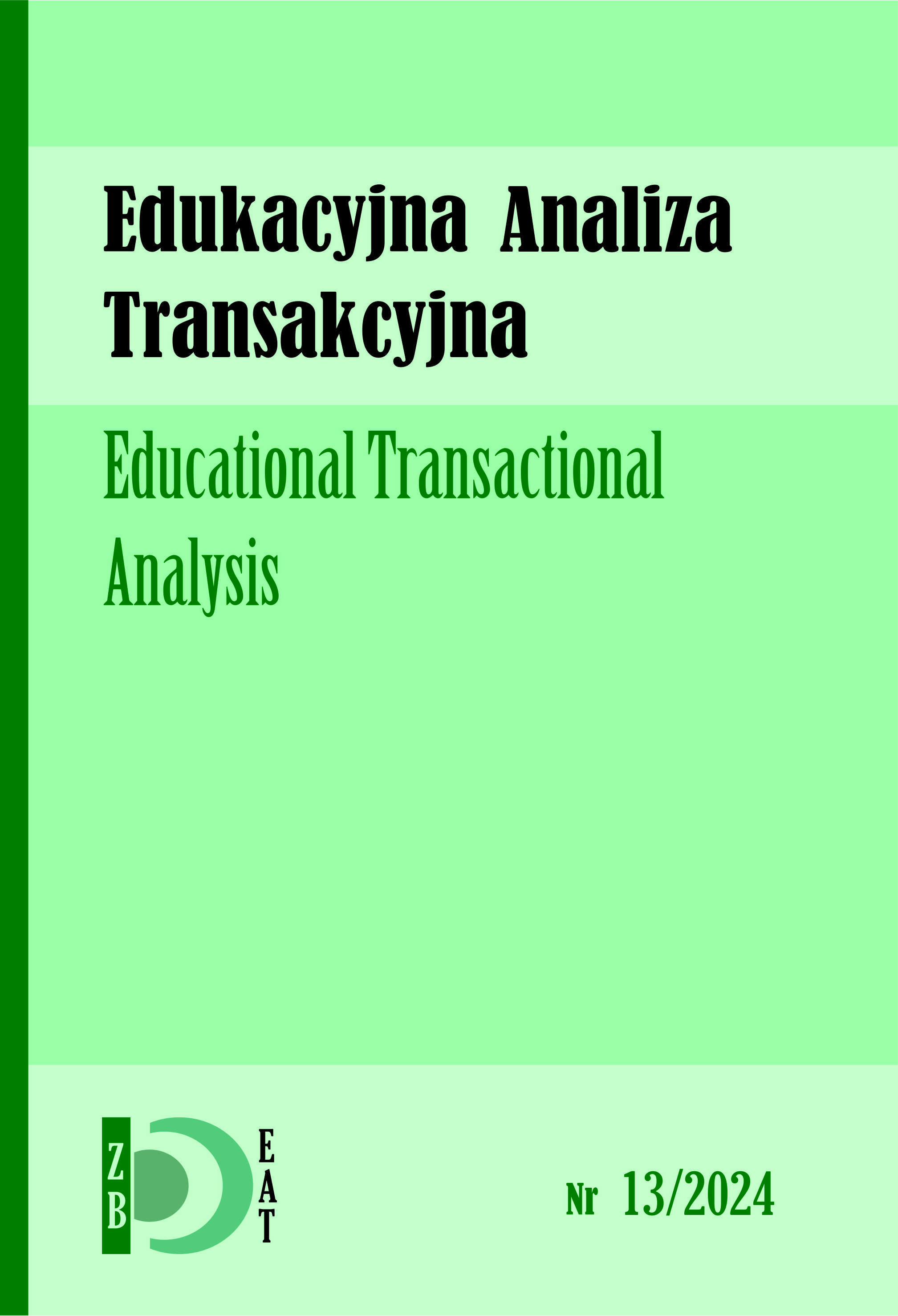The Profile of Ego States and the Experience of Positive and Negative Emotions in the Context of Cyber Threat Vulnerability
DOI:
https://doi.org/10.16926/eat.2024.13.08Keywords:
transactional analysis, ego states, affective traits, emotions, cybersecurityAbstract
Rapid technological development brings new opportunities and new challenges. Among the problems that have emerged with the development of computers and the Internet, cybersecurity issues are paramount. They can be analyzed from many perspectives, on many different levels, and in relation to various, often incomparable scales of impact. The protection against inappropriate content for adults must be approached differently than for underage Internet users. Securing personal devices against cybercriminal attacks is different from securing the infrastructure of companies and institutions. For computer science, the most important thing is to use appropriate software to secure computers and networks. From the perspective of social sciences, the primary focus is on the human being - the user of new technologies. The effectiveness of implemented technical solutions depends primarily on their characteristics, tendencies, knowledge, and skills. Cybersecurity thus appears as an interdisciplinary problem, in which technological and software issues are just as important as personality, social, and educational issues.
In this article, the author presents the results of their own research, in which an analysis was conducted of the profile of the self-states of computer users and their tendency to experience positive and negative emotions, in the context of their potential vulnerability to cyber threats.
Downloads
References
Ajayi, T. M. (2022). Discursive-manipulative strategies in scam emails and SMS: The Nigerian perspective. Lodz Papers in Pragmatics, 18(1), 175-195. https://doi.org/10.1515/lpp-2022-0008
Albladi, S. M., & Weir, G. R. S. (2017). Personality traits and cyber-attack victimisation: Multiple mediation analysis. 2017 Internet of Things Business Models, Users, and Networks, 1-6. https://doi.org/10.1109/CTTE.2017.8260932
Alevizopoulou, S., Koloveas, P., Tryfonopoulos, C., & Raftopoulou, P. (2021). Social media monitoring for IoT cyber-threats. W 2021 IEEE International Conference on Cyber Security and Resilience (CSR), Workshop on Data Science for Cyber Security (DS4CS @ IEEE CSR), Rhodes, Greece, July. IEEE.
Bada, M., & Nurse, J. R. C. (2020). The social and psychological impact of cyberattacks. W V. Benson & J. Mcalaney (Eds.), Emerging cyber threats and cognitive vulnerabilities (ss. 73–92). Academic Press. https://doi.org/10.1016/B978-0-12-816203-3.00004-6
Benavides-Astudillo, E., Silva-Ordoñez, L., Rocohano-Rámos, R., Fuertes, W., Fernández-Peña, F., Sanchez-Gordon, S., & Bastidas-Chalan, R. (2022). Analysis of vulnerabilities associated with social engineering attacks based on user behavior. W M. Botto-Tobar, S. Montes León, P. Torres-Carrión, M. Zambrano Vizuete, & B. Durakovic (Eds.), Applied Technologies. ICAT 2021. Communications in Computer and Information Science (Vol. 1535). Springer, Cham. https://doi.org/10.1007/978-3-031-03884-6_26
Berne E. (2005). Dzień dobry i co dalej. Poznań: Rebis
Brzozowski P. (2010). Skala uczuć pozytywnych i negatywnych SUPIN. Polska adaptacja skali PANAS Davida Watsona i Lee Anny Clark. Podręcznik. Warszawa: Pracownia Testów Psychologicznych Polskiego Towarzystwa Psychologicznego
Castells M. (2003). Galaktyka Internetu. Poznań: Rebis
Dave, D., Sawhney, G., Aggarwal, P., Silswal, N., & Khut, D. (2023). The new frontier of cybersecurity: Emerging threats and innovations. 2023 29th International Conference on Telecommunications (ICT), 1-6. https://doi.org/10.48550/arXiv.2311.02630
Dunn Cavelty, M., Eriksen, C., & Scharte, B. (2023). Making cyber security more resilient: Adding social considerations to technological fixes. Journal of Risk Research, 26(7), 801-814. https://doi.org/10.1080/13669877.2023.2208146
Fredrickson, B. L. (2001). The role of positive emotions in positive psychology: The broaden-and-build theory of positive emotions. American Psychologist, 56(3), 218–226. https://doi.org/10.1037/0003-066X.56.3.218
Gross, J.J. (2002), Emotion regulation: Affective, cognitive, and social consequences. Psychophysiology, 39: 281-291. https://doi.org/10.1017/S0048577201393198
Hemphill, J. F. (2003). Interpreting the Magnitudes of Correlation Coefficients. American Psychologist, 58(1), 78-79. https://doi.org/10.1037/0003-066X.58.1.78
Łęski, Z. (2016). Duch w maszynie… Kim jest dla nas komputer? Charakterystyka relacji w języku analizy transakcyjnej. Częstochowa: Wydawnictwo AJD w Częstochowie.
Łęski, Z., Kurkowski, M., Gozdecki, B., & Steingartner, W. (2024). Czy można zakochać się w Jessice? — czyli o Nigeryjskim Przekręcie z perspektywy Analizy Transakcyjnej. Przegląd Policyjny, 152(4), 249-261. https://doi.org/10.5604/01.3001.0054.4340
Martowska K. (2012). Lista przymiotnikowa ACL. Harrison G. Gough, Alfred B. Heilburn, Jr. Polska normalizacja. Podręcznik. Warszawa: Pracownia Testów Psychologicznych Polskiego Towarzystwa Psychologicznego.
Nunnally, J. C., & Bernstein, I. H. (1994). Psychometric theory (3rd ed.). New York: McGraw-Hill.
Pierzchała A. (2010). Rodzic, Dorosły, Dziecko – jak można opisać komunikację na forach internetowych. W M. Sokołowski (red.). Oblicza Internetu. (Re)definiowanie sieci. Elbląg: Wydawnictwo PWSZ w Elblągu
Ryan, R. M., & Deci, E. L. (2000). Self-determination theory and the facilitation of intrinsic motivation, social development, and well-being. American Psychologist, 55(1), 68–78. https://doi.org/10.1037/0003-066X.55.1.68
Sanders, B. G., Dowland, P. S., & Furnell, S. (2009). An assessment of people’s vulnerabilities in relation to personal and sensitive data. W Advances in Communications, Computing, Networks and Security: Proceedings of the MSc/MRes programmes from the School of Computing, Communications and Electronics, 2007-2008 (Vol. 6, p. 124). University of Plymouth.
Stevart, I., Joines, V. (2016). Analiza transakcyjna dzisiaj. Poznań: Rebis
Tugade, M.M., Fredricson, B.L. (2007). Regulation of positive emotions: emotion regulation strategies that promote resilence. Journal of Happiness Studies, (2007)8, 311-333. DOI: 10.1007/s10902-006-9015-4.
Wieczorek, Z. (2017). Język zmiany w analizie transakcyjnej. Edukacyjna Analiza Transakcyjna, 6,145–156. DOI: 10.16926/eat.2017.06.09
Žvelc, G. (2010). Relational schemas theory and transactional analysis. Transactional Analysis Journal, 40(1), 8-17. https://doi.org/10.1177/036215371004000103
Published
How to Cite
Issue
Section
License
Copyright (c) 2024 Zbigniew Łęski

This work is licensed under a Creative Commons Attribution 4.0 International License.
I am aware that the Educational Transactional Analysis journal is published under a Creative Commons license - Attribution (https://creativecommons.org/licenses/by/4.0/legalcode).
By submitting the article, I agree to make it available under this license

